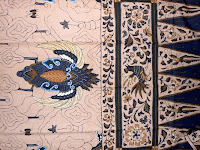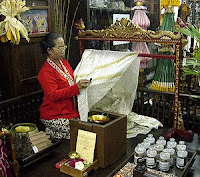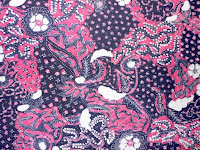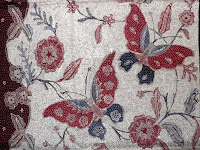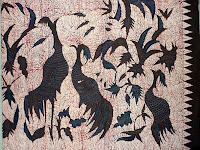The process continues by adding additional wax to embellish the design or preserve areas in the color of the initial dye bath. The cloth is then dipped in a second dye bath. This process is repeated a number of times depending on the number of dyes involved. Producing a high quality of batik fabric is time consuming, complicated and requires a high degree of skill. The longer the process, the more expensive the price of batik is.
Historical
Some said batik originated from Majapahit kingdom era and it was for the king family’s fashion and then continued to the Mataram Sultanate era in Central Java. Therefore, places like Jogjakarta, Solo, Pekalongan, Rembang, Semarang, Tegal in Central Java are famous of batik production.
Javanese traditional batik, especially from Jogjakarta and Solo, has special meanings refers to the Javanese conceptualization of the universe. Traditional colors of indigo, dark brown and white represent the three major Hindu Gods (Brahma, Visnu and Siva). This is related to the fact that natural dyes are only available in indigo and brown.
Batik then widely spreads to other areas such West Java such Cirebon, Garut, Ciamis, Tasikmalaya, and also East Java such Madura, Ponorogo, Sidoarjo. However, batik then becomes public fashion, some areas in Indonesia also produce their own unique patterns of batik.
Batik origins that quite famous
Batik Jogjakarta
Jogjakarta is known as the heart of the batik art. Some patterns are symbols that related to Hindu-Javanese culture. The uniqueness of motifs comes from a number of large geometric designs. Each motif has a meaning and can only be worn in the special occasion based on the meaning of batik’s motifs.
Batik Solo
Also known as Batik Surakarta. Pretty much like batik Jogjakarta, some motifs are also influenced from the Hindu-Javanese culture. Every pattern drawn has their own meaning, such wider stripes or wavy lines of grater width indicated higher rank and nobility.
Batik Lasem
Lasem is located in Rembang, which lots of home industries produce batik can be found. Batik from Lasem mostly comes in two natural colors. The red one is very unique because the color is produced by ‘manggis’ fruit. The motifs usually dominated by animals such variant of birds.
Batik Pekalongan
Famous of so called batik pesisir, literally means coastal batik. Batik pesisir pekalongan is quite famous with the Dutch motifs and Chinese motifs, with soft gradation in color.
Batik Madura
People classify batik Madura as seashore batik, and characterized by motifs most about life and environments, such birds, butterfly and flowers, with hints of Chinese art. The colors are bold and clear represented the battle of Madura’s people to reject domination of King fro Java in the year of thousand and six hundreds. The color is also represented the attitude of consistency.
Batik Cirebon
Historically, Cirebon has two kingdoms, Kasepuhan and Kanoman Kingdom, and based on those two kingdoms with a touch of Chinese culture, influenced most of batik Cirebon motifs. The characteristics of batik Cirebon are the base color is lighter than the line from the major design, most decorated it with special cloud motif called mega, and use single thin line with strong color.

